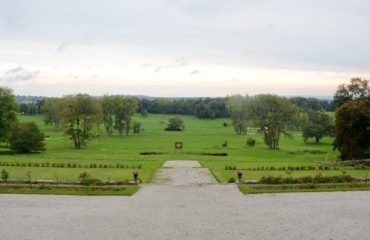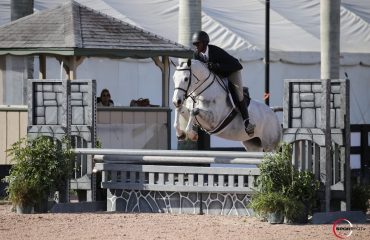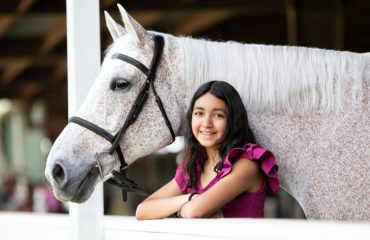By Dani Moritz
When Jeanette Sassoon bred her black Dutch stallion, Valiant, to her newly acquired mare, Caprice, she named the foal Valiant. Little did she know at that time just how much he would embody his name.
Born on the wild side, Valiant always had an exuberant spirit. When he was only two-years-old, Jeanette had a well-respected German dressage trainer evaluate his potential. As they stood at the bottom of a mountain looking up at five horses, Jeanette whistled for the horses to come in. All but one took the long, winding path. Valiant was the one who chose a different route. Using the bushes and boulders as if they were flagged gates on a giant slalom course, Valiant weaved his way at lightning speed straight down the mountain.
Jeanette recalls the trainer immediately dove for cover then deemed Valiant unsuitable for dressage. He told her, “He’s crazy and too small. Get rid of him. He’ll never do.”
Reluctantly, Jeanette put Valiant up for sale – only to discover that he could not pass the vet check because of an alleged degenerative disease he didn’t really have. Then, the unthinkable happened. Soon after moving to a new farm in Florida, Valiant stepped on a horseshoe nail. After treatment from the vet, abscesses developed at the site where injections were given and the following morning a raging infection spread to Valiant’s eyes and nearly killed him. He developed Uveitis, more commonly known as moon blindness. Fortunately, Valiant survived – but he had completely lost his sight.
Jeanette was given two choices. She could turn him out in a pasture without trees for the rest of his life or put him down. Jeanette choose neither and her life was forever changed. “When I was told Valiant was permanently blind, I really couldn’t process that intellectually. It was so emotional and it was so shocking to my system to know that this beautiful, wonderful, incredible, gorgeous animal wouldn’t ever be able to see again.”

Despite being completely blind, Valiant has shared an incredibly journey with Jeannette.
Photo by www.BarbarasVisions.com
Her fiancé, Gary Fellers, took her back to Valiant’s stall to reflect on the situation and, after hugging Valiant, Gary said, “He isn’t lame is he?” That was the right question that led to the right answer. They decided they would find a way to take care of him, give him a good quality of life and teach him how to live without his sight. It was then that Jeanette’s life began to change and she began to see life differently.
When the veterinarians asked Jeanette what she was going to do, she said she was going to help him overcome the infection and train him to the highest level of dressage possible. “I had no idea what I had said because I didn’t have a clue how to train a blind horse, but I knew a little about dressage and in the moment I was quite defensive about even thinking or saying ‘putting Valiant down’ but it was something that just came out of my mouth and felt right at the time,” she said. “When someone says something is impossible, how would they know if they haven’t ever tried it?”
Reflecting on what happened she said, “You have to believe things are there for a reason and they’re there for a learning experience and opportunity,” she said. “We need to first of all believe in ourselves, which sometimes takes a lot of courage but when you take that first step it is so rewarding. We can take on a challenge and we can do it.”
Jeanette believed and pressed on. “This was the beginning of an experience of understanding horses in a whole different way for me. In order to communicate with Valiant, I had to understand him and all his natural tendencies including his fears, needs, comforts and idiosyncrasies. Becoming quiet within myself and watching his body language was the key.”
Throughout Valiant’s training, Jeanette had to become aware of Valiant’s space and senses and, most importantly, she had to emphasize safety at all times. Because horses are flight animals their natural instinct is to run which can create dangerous situations quickly.
She began his training by utilizing voice and touch to set the foundation for their communication. Jeanette says utilizing high and low pitch helped Valiant navigate his approach to different situations and objects. Next, she focused on the halt cue to keep Valiant from dangerous situations whether he was on a lead or not. Next, she focused her attention on the backing cue and once that was mastered she moved onto forward. Learning to walk and trot came after he learned the basics and then she was slowly able to introduce lunging. She also taught him stay by putting a full flat hand on his face and rewarding him when he stayed and she taught him come after he understood the stay cue. It was important to reward him every time he did something right and avoid punishment in order to make learning a positive experience.

Jeanette celebrates with Valiant after their musical freestyle performance at the 2013 World Dressage Masters in Wellington, Florida.
Photo by Alan Fabricant
She spent time learning to perceive the world as he did. She also employed the help of John Lyons, a horseman known for his ability to communicate with horses. “I was blessed to have ever met John,” she said. “He has changed the way I approach and understand our four-leggeds, which in turn has helped me understand life a whole lot better.”
She added, “John has a special way of taking our communication and interaction with our horses and relating that to our communication and interaction with life itself. Like John said, ‘It’s not just about going to a horse show. It’s not just about winning a ribbon. It’s not just about going to the Olympics or about riding a blind horse. It’s about how we deal with life and how we deal with the challenges of life’.”
Day-by-day and step-by-step, Jeanette and Valiant became closer and closer and soon they graduated from the confinements of the arena to the mountain trails and wide open spaces of the Big Horn Mountains in Wyoming where both of them could enjoy nature together. “For Valiant and me, it’s the ultimate experience to have that mutual trust to be able to go places where we can relate to the wonder and beauty of life in that way.”
Jeanette also realized her goal of competing with Valiant at the international level of dressage in Wellington, Florida against the top horses in the country. Last year, they competed their first Prix St. Georges test. “Valiant was great,” she said. “His very last performance of the season he came in sixth out of 15 horses and we were pretty excited to fulfill that goal we set out to accomplish 17 years ago.”
At 26 years old, Valiant is now retired from competition so he can focus on enjoying life and performing musical freestyle demonstrations. He recently performed at the World Dressage Masters in Wellington, Florida and the duo was invited to perform during the 2013 Rolex Three-Day Event at the Kentucky Horse Park. “We hope that we can reach more and more people and just spread the wonderful message of hope, caring, trust and above all love and respect for all life,” she said. “It seems that at this point in our journey we are meeting people that believe and care as we do. We are so proud to have Adequan join us on our journey.”
A documentary about Valiant’s life is currently in production and will be shown at the 2014 film festivals and will later be released through network, cable or independent distribution channels.
In addition to the documentary, two screenplays are in the works with hopes of a feature motion picture “based on a true story” about Valiant’s journey. Jeanette and Valiant are also giving back through The Valiant Trust, Inc. – a not-for-profit corporation founded to further research and development. The trust aids educational, medical and humanitarian projects such as Ophthalmology research, support for guide dog organizations, developments in therapeutic riding, promotion of equine communication networking, special projects and a scholarship fund.
Looking back, Jeanette says she had no concept of how much Valiant would impact her life and the lives of others. “I had no idea that our journey would bring us to this point. Now, maybe we can give back in our little way to hopefully help make a better place for our horses in this circle of life.”
Follow Valiant’s journey at valiantdocumentary.com.

















